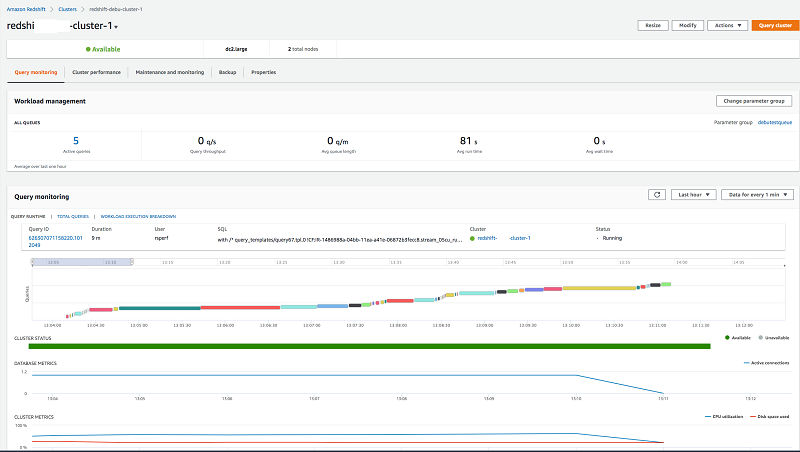AWS Big Data Blog
Tag: Amazon Redshift
Speeding up Etleap models at AXS with Amazon Redshift materialized views
The materialized views feature in Amazon Redshift is now generally available and has been benefiting customers and partners in preview since December 2019. One customer, AXS, is a leading ticketing, data, and marketing solutions provider for live entertainment venues in the US, UK, Europe, and Japan. Etleap, an Amazon Redshift partner, is an extract, transform, […]
Lower your costs with the new pause and resume actions on Amazon Redshift
Today’s analytics workloads typically require a data warehouse to be available 24 hours a day, 7 days a week. However, there may be times when you need an Amazon Redshift cluster for a short duration of time at frequent (or infrequent) intervals. For example, you may run a periodic ETL job or use a cluster […]
Integrate Power BI with Amazon Redshift for insights and analytics
July 2022: This post was reviewed for accuracy. Amazon Redshift is a fast, fully managed, cloud-native data warehouse that makes it simple and cost-effective to analyze all your data using standard SQL and your existing business intelligence (BI) tools. Microsoft Power BI is a business analytics service that delivers insights to enable fast, informed decisions. […]
Analyze your Amazon S3 spend using AWS Glue and Amazon Redshift
The AWS Cost & Usage Report (CUR) tracks your AWS usage and provides estimated charges associated with that usage. You can configure this report to present the data at hourly or daily intervals, and it is updated at least one time per day until it is finalized at the end of the billing period. The […]
Amazon Redshift at re:Invent 2019
The annual AWS re:Invent learning conference is an exciting time full of new product and program launches. At the first re:Invent conference in 2012, AWS announced Amazon Redshift. Since then, tens of thousands of customers have started using Amazon Redshift as their cloud data warehouse. In 2019, AWS shared several significant launches and dozens of […]
Maximize data ingestion and reporting performance on Amazon Redshift
This is a guest post from ZS. In their own words, “ZS is a professional services firm that works closely with companies to help develop and deliver products and solutions that drive customer value and company results. ZS engagements involve a blend of technology, consulting, analytics, and operations, and are targeted toward improving the commercial […]
ETL and ELT design patterns for modern data architecture using Amazon Redshift: Part 2
New: Read Amazon Redshift continues its price-performance leadership to learn what analytic workload trends we’re seeing from Amazon Redshift customers, new capabilities we have launched to improve Redshift’s price-performance, and the results from the latest benchmarks. Part 1 of this multi-post series, ETL and ELT design patterns for modern data architecture using Amazon Redshift: Part 1, […]
ETL and ELT design patterns for lake house architecture using Amazon Redshift: Part 1
New: Read Amazon Redshift continues its price-performance leadership to learn what analytic workload trends we’re seeing from Amazon Redshift customers, new capabilities we have launched to improve Redshift’s price-performance, and the results from the latest benchmarks. Part 1 of this multi-post series discusses design best practices for building scalable ETL (extract, transform, load) and ELT (extract, […]
Simplify management of Amazon Redshift clusters with the Redshift console
Amazon Redshift is the most popular and the fastest cloud data warehouse. It includes a console for administrators to create, configure, and manage Amazon Redshift clusters. The new Amazon Redshift console modernizes the user interface and adds several features to improve managing your clusters and workloads running on clusters. The new Amazon Redshift console provides visibility to the health and performance of clusters from a unified dashboard, simplified management of clusters by streamlining several screens and flows, improved mean-time-to-diagnose query performance issues by adding capabilities to monitor user queries and correlate with cluster performance metrics, as well as the ability for non-admin users to use Query Editor.
Orchestrate Amazon Redshift-Based ETL workflows with AWS Step Functions and AWS Glue
In this post, I show how to use AWS Step Functions and AWS Glue Python Shell to orchestrate tasks for those Amazon Redshift-based ETL workflows in a completely serverless fashion. AWS Glue Python Shell is a Python runtime environment for running small to medium-sized ETL tasks, such as submitting SQL queries and waiting for a response. Step Functions lets you coordinate multiple AWS services into workflows so you can easily run and monitor a series of ETL tasks. Both AWS Glue Python Shell and Step Functions are serverless, allowing you to automatically run and scale them in response to events you define, rather than requiring you to provision, scale, and manage servers.









